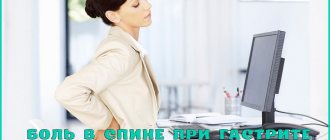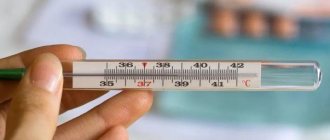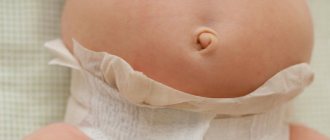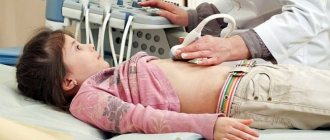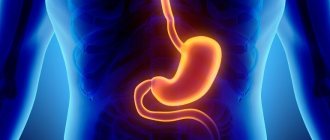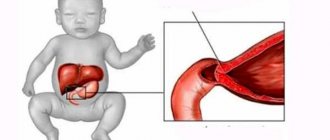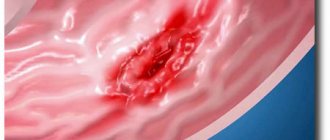Can your stomach hurt?
With thoracic osteochondrosis, stomach pain may occur. If other parts of the spine are affected, then no. This is due to the fact that as the nervous tissue is involved, the vertebrae or muscles with hypertonicity compress the nerve roots. Most of the internal organs in the chest and abdomen are connected to the nervous tissue of the thoracic spine. When it is pinched, pain impulses can be transmitted to organs.
Symptoms
The causative factors that provoke abdominal pain in the presence of osteochondrosis are provoked by both irritation of the nerve endings of the spine and the progression of stomach pathologies due to prolonged use of NSAIDs. They may have the following symptoms:
- Heaviness and pain in the stomach after eating is explained by impaired motor skills caused by irritation of nerve endings.
- An aching, dull pain in the right hypochondrium develops with lumbago and pinching of the nerve roots by the vertebrae.
- Superficial pain that goes away after taking a comfortable body position and intensifies during physical activity.
- The localization of pain is in the spine, and the stomach is the place of irradiation.
- Increased discomfort after taking medications.
If the patient feels sick, vomits, the body temperature rises and there is pain in the lower abdomen, then a comprehensive diagnosis is necessary. In this case, the clinical picture characteristic of osteochondrosis may be caused by other diseases: ulcer, gastritis, enterocolitis.
Digestive problems can be short-term, eliminating after discontinuation of NSAID medications, or they can manifest themselves as a symptom of an independent disease. If there is no exact certainty whether the stomach hurts due to osteochondrosis or due to irritation of its mucous membrane, then differential diagnosis will be required. The following symptoms should alert you:
- heartburn occurs after eating;
- the pain is deep, internal, sharp, stabbing and cutting;
- unpleasant manifestations do not depend on the time of day or body position;
- temperature rises;
- a number of additional symptoms of digestive system disorders develop.
Differential diagnosis is extremely important, since with its help it is possible to recognize diseases that are similar in manifestation but different in etiology.
The influence of osteochondrosis on the functioning of the stomach
Infringement of nerve tissue affects the muscles, since it is to them that pain impulses are transmitted. Many structures of the gastrointestinal tract are muscular in nature, so osteochondrosis can have a pronounced effect. Stomach pain with osteochondrosis can occur for two reasons:
- Innervation, that is, discomfort occurs because the pinched nerve root sends an unpleasant impulse throughout the nerve, right up to the stomach tissue;
- Spastic, that is, compression of the nervous tissue leads to spasm in the muscles of the gastrointestinal tract, which causes pain (in this case, a number of accompanying symptoms may occur, such as heartburn, belching).
The second option is much more common than the first. This discomfort has typical characteristics; it is usually quite easy to differentiate from pain caused by gastrointestinal pathology.
This influence can lead to a number of unpleasant consequences. Among them are not only pain syndrome, but vascular disorders, various spasms. Also, complete compression of a nerve can cause paralysis.
Can there be heartburn with osteochondrosis?
Have you been trying to heal your JOINTS for many years?
Head of the Institute for Joint Treatment: “You will be amazed at how easy it is to heal your joints by taking every day...
Read more "
Vegetative-vascular dystonia rarely appears as an independent disease. Often this is a consequence of degenerative changes in the spine - osteochondrosis. According to localization, cervical, cervicothoracic, thoracic, lumbar and lumbosacral osteochondrosis are distinguished.
VSD and osteochondrosis are very similar in individual clinical symptoms, so an in-depth laboratory and x-ray examination is required to make an accurate diagnosis.
Symptoms
| Localization | Osteochondrosis | General signs | VSD |
| Cervical osteochondrosis | — headache;— dizziness;— pain in the neck, shoulders, back of the head;— difficulty turning and tilting the head;— hearing loss;— “ringing” in the ears;— “floaters” before the eyes;— increased blood pressure (blood pressure); - blurred vision; - nausea and vomiting; - impaired swallowing; - sore and dry throat; - loss of consciousness. | - headache and dizziness; - hearing and vision impairment; - increased blood pressure; - nausea and vomiting; - loss of consciousness. | - pain behind the sternum, in the area of the heart; - arrhythmia (irregular heart rhythm); - a feeling of heaviness and congestion in the chest; - difficulty breathing; - uneven breathing (too deep inhalation or exhalation); - fluctuations or too sharp increase/decrease in blood pressure ;— unstable body temperature (ranges from 35° to 38°);— gastrointestinal disorders (stomach pain, vomiting, heartburn, diarrhea or constipation);— pain when urinating;— increased irritability;— sudden changes in mood;— tearfulness and touchiness; - a feeling of causeless anxiety, fear of death; - disturbances in night and daytime sleep and other symptoms. |
| Cervicothoracic osteochondrosis | — frequent headaches; — decreased performance; — sleep disturbance (insomnia at night, drowsiness during the day); — tearfulness, touchiness, irritability; — “floaters” before the eyes and “ringing” in the ears; — sudden jumps in blood pressure; — disturbance of gait and general coordination of movements; - impaired sensitivity in the shoulders, arms (up to complete loss); - toothache. | - migraine-type headaches; - sleep disturbances; - decreased performance; - personality changes (tearfulness, irritability); - hearing and vision impairment; - changes in blood pressure. | |
| Thoracic osteochondrosis | - chest pain; - feeling of heaviness and burning in the chest; - sharp paroxysmal pain during deep inhalation/exhalation. bending over, coughing and sneezing; - loss of sensitivity in the chest area; - numbness radiating to the left arm; - “masked” pain in the heart, stomach, liver; - nocturnal nature of attacks of pain; - feeling of fear of death. | - pain behind the sternum in the heart area; - heaviness in the chest; - pain in the stomach; - feeling of fear of death. |
Differential (comparative) diagnosis
VSD and cervical osteochondrosis, as well as thoracic and cervicothoracic, are a consequence and a cause. If the cause is not cured, the consequences will not disappear, they will only be muffled for a while and will periodically make themselves felt.
Therefore, when the first signs of one of these diseases appear, you should consult a doctor.
A competent specialist will first find out all your complaints, collect an anamnesis of your life and illness, and conduct an external examination of your back. Based on the information received during the survey and examination, he will prescribe an additional examination.
The most important thing is not to hide any symptoms that may bother you or that seem unrelated to the disease. Signs that seem harmless at first glance can be decisive in making the correct diagnosis.
To clarify the preliminary diagnosis and determine the cause of the development of vegetative-vascular dystonia and osteochondrosis, methods such as x-ray examination of the spine, magnetic resonance or computed tomography are used. These studies are the most informative for making a more precise diagnosis and detecting any other (hidden) diseases. Based on the examination results, the patient is prescribed or adjusted treatment for VSD and osteochondrosis.
Causes and prevention
| Cause | Prevention |
| Sedentary lifestyle | Include in your daily routine morning exercises, walking in the fresh air, sports games, running, swimming, skiing, cycling, dancing; get into the habit of resting actively, not passively. |
| Increased load on the spine |
|
| Incorrect posture |
|
| Spinal injuries |
|
| Disorders of metabolic processes and blood circulation in the intervertebral disc |
|
Prevention must be carried out constantly, even if you do not have osteochondrosis, and treatment must be carried out immediately, when the first symptoms of the disease appear. And most importantly, you must always remember that by curing the cause of the disease, you also get rid of its consequences.
Source: https://lokot.taginoschool.ru/simptomy/mozhet-li-byt-izzhoga-pri-osteohondroze/
Symptoms of stomach pain with osteochondrosis
Pain in the epigastrium with osteochondrosis has characteristic features. Their symptoms are as follows:
- Simultaneously with discomfort in the stomach, discomfort appears in the corresponding part of the spine - sometimes with movement, sometimes with pressure, sometimes at rest;
- Discomfort may increase when performing physical exercises on the flexibility of this area;
- The pain is clearly localized - the patient can accurately show the painful area, since it is not diffuse;
- Subjectively, the sensation of discomfort is localized in not very deep layers of tissue;
- During coughing and defecation, discomfort increases;
- The localization of unpleasant sensations is shifted to one side or another;
- Manifestations of discomfort usually coincide with exacerbation of osteochondrosis;
- Unpleasant sensations are present for a long time and are aching in nature;
- Unpleasant sensations are also accompanied by a feeling of stiffness in the back;
- As a result of the spasm, heartburn and belching may also appear due to osteochondrosis of the thoracic region.
The symptoms are quite uncharacteristic and can be quite difficult to differentiate if osteochondrosis has not been previously diagnosed. But it occurs infrequently - it affects only 10-15% of all patients with osteochondrosis of the thoracic spine.
Heartburn with osteochondrosis of the thoracic region
Osteochondrosis of the thoracic spine is a rare pathology and the most “insidious form” of osteochondrosis. Due to its anatomical features, this part of the spine is subject to degeneration relatively rarely.
The twelve vertebrae of the department are very firmly connected to each other and are perfectly protected by a kind of corset of muscles, which significantly limits the range of movements between them. The ribs give additional rigidity to the vertebrae.
The most likely cause of the formation of osteochondrosis of the chest is scoliosis, which forms at the school desk. Risk factors for intervertebral disc damage may include:
- hereditary factor;
- poor nutrition and excess weight;
- work activity associated with movement restrictions;
- excessive physical activity;
- age factor and hypothermia;
- instability of vertebral disc segments;
- smoking and nervous tension;
- bruises, fractures and spinal injuries are the most predisposing factor for the formation of thoracic osteochondrosis.
Symptoms and signs
A distinctive sign of thoracic osteochondrosis is pain. It is usually divided into types:
1. Lumbago – dorsago. The manifestation of acute, sudden pain in the area of the affected vertebral discs.
Symptoms of osteochondrosis of the thoracic spine are the result of a prolonged sedentary position, when you have to sit at a table, bending over, for a long time. Sharp pain (lumbago) occurs when you try to stand up or raise yourself.
2. Dorsalgia. Increased pain when trying to take a deep breath and when moving the body. The back muscles are tense, and movement may be limited in any spinal region.
Visceral (internal) manifestations
With osteochondrosis of the chest, the symptoms are rich in internal (visceral) manifestations.
Damage to the upper thoracic nerve roots causes pain in the esophagus and pain in the pharynx.
Pressure on the affected area of the spine causes increased pain. It can be paroxysmal in nature.
Symptoms of osteochondrosis of the thoracic region, manifested by pain in the stomach, indicate damage to the nerve endings of the mid-thoracic region, which provoke increased pain when lying on the back for a long time.
Compression of the 8th and 9th spinal roots causes pain in the duodenum. The sensitivity of the anterior abdominal wall is impaired.
Impaired gastric motility (secretion and peristalsis) is a characteristic symptom of thoracic osteochondrosis.
- nausea and vomiting;
- heartburn;
- pain in the left hypochondrium;
- flatulence;
- diarrhea or constipation.
Dysfunction of the duodenum (secretory and motor) leads to:
- nausea and belching;
- there is pain and a feeling of heaviness in the right hypochondrium.
Very often, osteochondrosis of the thoracic region manifests itself with symptoms characteristic of other diseases, for example, angina pectoris. Pain in the heart is noted: cutting, pressing, burning the heart or squeezing the throat.
With laryngospasm - the result of pathology at the level of the cervical vertebrae, symptoms develop:
When treating thoracic osteochondrosis, the symptoms and manifestations of which are similar to pulmonary pathology, it is necessary to accurately establish their involvement in the disease of the spine.
Treatment of osteochondrosis of the thoracic spine
When drawing up a treatment plan that determines how to treat osteochondrosis of the thoracic region, diagnostic data based on an x-ray examination help.
Such an examination gives a clear idea of how to treat thoracic osteochondrosis, because x-ray readings indicating the proliferation of vertebral bodies and the presence of changes in the intervertebral distance (decreased height) are a characteristic symptom of this disease.
Based on the data of the diagnostic examination, the leading symptoms are determined, the clinical diagnosis is clarified, which makes it possible to determine the correct tactics.
Treatment of osteochondrosis of the thoracic spine directly depends on the syndromes, stage of development and the presence of underlying diseases.
To relieve pain, restore impaired functions of the nerves of the spinal roots, and prevent the progression of dystrophic changes in the structure of the spine, a conservative method is used, combined with complex, step-by-step treatment.
Treatment of thoracic osteochondrosis includes a number of physiotherapeutic procedures:
- inductometry and electrophoresis;
- laser therapy and vacuum therapy;
- sinusoidal-modeled and diadynamic currents;
- magnetic and pharmacopuncture;
- acupuncture.
- vasoregulating diuretics and muscle relaxants (muscle relaxants and venotonics);
- paravertebral novocoin blockades.
Physiotherapy
Physical therapy for thoracic osteochondrosis is the main stage of the recovery process. Strengthens muscles and mobility of the spine. Exercises for thoracic osteochondrosis help improve ventilation in those patients in whom deep breathing causes pain.
Gymnastics for osteochondrosis of the thoracic region is effective:
- when the spine is stretched;
- when establishing proper breathing.
But we must not forget that gymnastics for thoracic osteochondrosis is effective only when all causes of the disease are identified and eliminated.
If the prescribed course of treatment does not bring positive results, various methods of surgical intervention are used, based on the severity of symptoms and the level of destruction.
Cervical-thoracic osteochondrosis
Cervicothoracic osteochondrosis is a disease caused by processes (degenerative-dystrophic) affecting the discs of the cervical spine.
Vertebrae located close to each other are not adequately protected by a relatively poorly developed muscular frame. Even the slightest strain on the neck causes myelopathy.
Main symptoms
Symptoms of cervicothoracic osteochondrosis appear:
- sensitivity disorder of the muscles of the neck, skin, hands and face;
- headaches and attacks of dizziness;
- unsteadiness of gait;
- increased fatigue, deteriorating vision and hearing.
The pain radiates into the arm, spreading from the shoulder to the fingertips, causing numbness of the skin, even a slight movement of the neck can cause a sensation of electric current along the entire arm.
Myelopathy can cause:
- disorders of the lungs and heart;
- double vision;
- numbness of the tongue.
Treatment of exacerbation of the disease
The use of complex therapy in the treatment of exacerbation of cervicothoracic osteochondrosis makes it possible to obtain a lasting positive result. It includes:
- The method of orthopedic correction is fixation of the neck with a Chance collar, which supports the head, significantly relieving the cervical vertebrae of tension, and promotes their alignment.
- A method using pharmacopuncture - anti-inflammatory drugs (preferably homeopathic - Traumeel) to relax spasmodic muscles and prevent worsening of radicular compression.
- Chondroprotectors - to prevent the development of destruction in cartilage tissues - the drug Tsel T
- Drugs that help strengthen the ligamentous apparatus of the vertebral discs - the drug Alflutop.
- Acupuncture is used to quickly relieve pain, relieve muscle spasms, and restore the functioning of spinal nerves. This method is very effective and its use during an exacerbation period prevents the progression of the disease for many years.
- Hirudotherapy - treatment with leeches helps to scar the damaged fibrous rings in the discs, eliminate swelling of the nerve roots, and improve blood circulation in the spinal discs.
- Drug therapy - biogenic stimulants, drugs that improve peripheral circulation, vitamins.
- Massage – to relax spasmed muscles, to restore and strengthen them.
In the final period of treatment, provided that muscle spasms and inflammatory processes are eliminated, manual therapy, osteopathy, and exercise therapy are included.
Timely treatment of any disease will prevent exacerbations and various complications caused by them.
Source: https://gkhuss.ru/izzhoga-pri-osteohondroze-grudnogo-otdela/
How to stop burping?
Belching in this case is a symptom of spasm of the stomach muscles. And to get rid of it, you need to relieve the spasm itself. This is achieved by taking antispasmodics, such as No-shpa. A single dose is sufficient to relieve an attack.
But the very elimination of the causes of pain and other symptoms consists in treating osteochondrosis and transferring it into remission. To do this, in the presence of pain, a course of non-steroidal anti-inflammatory drugs (Ibuprofen, Ortofen, Nurofen) is administered. Also, to relieve muscle hypertonicity and spasm, they take antispasmodics (No-spa) and muscle relaxants (Mydocalm) in a course. To stop the progression of the disease, doctors prescribe chondroprotectors (Chondroxide) and B vitamins. Normal blood supply to the discs is facilitated by taking vasodilators (Actovegin), which normalize blood circulation.
Massage, physiotherapy (magnetic therapy and electrophoresis), and proper diet have a good therapeutic effect.
Can my intestines hurt because of my spine?
At the initial stage of compression of the radicular nerves, the spine can cause pain in the intestines due to spasm of the muscle wall and irradiation of unpleasant sensations from the paravertebral muscles in the lumbar region. If the lower lumbosacral spine is affected, then most likely the pain in the intestines is not real, but is a reflection of the fact that the muscles in the lumbar region are overstrained.
The answer to the question of whether the spine can hurt from the intestines is affirmative. Yes, indeed, in approximately half of the clinical cases diagnosed with colitis, Crohn's disease, and ulcerative colitis, the cause of these pathologies is a violation of innervation.
After all, if the process of peristalsis is disrupted for a long time, then toxins accumulate in the intestinal cavity. They have a negative effect on the epithelium, destroy it, provoke inflammation, the appearance of ulcers, etc.
The subsequent process of disruption of vitamin synthesis can lead to intestinal bleeding and constant inflammatory processes. Often such situations lead to the development of cancer. A distinctive characteristic of the vertebrogenic inflammatory process in the intestine is the absence of positive dynamics when attempting pharmacological treatment.
Now you know whether the intestines can hurt due to the spine, all that remains is to figure out what to do about it and how to properly carry out complex treatment.
Diagnostics
Diagnostics is carried out simultaneously in two directions:
- Exclusion of gastric pathology using gastroscopy and auxiliary methods;
- Confirmation of the presence of osteochondrosis using manual examination, CT, MRI, X-ray.
Usually, a manual examination and simple exercises are enough to understand that with loads on the spine, the unpleasant sensations intensify. This means that their cause is damage to the intervertebral discs.
Does the spine affect bowel function?
To answer this question about whether the spine affects the intestines, you need to understand that all functions of this digestive organ are provided through innervation. And innervation is carried out through the structures of the spinal cord and the radicular nerves extending from it. Therefore, any pathology of the spinal column in the thoracolumbar region entails inevitable disruption of the small and large intestines.
If you look into the question of whether the spine affects the functioning of the intestines, many things will become obvious. Here are just a few facts:
- Bile plays a huge role in the functioning of the intestines (this substance produced by liver cells is excreted through the common bile duct into the cavity of the duodenum);
- bile breaks down fats, neutralizes the effect of hydrochloric acid contained in the stomach, helps cleanse the intestinal walls of waste, toxins and deposits;
- when the thoracic radicular nerves are damaged, biliary tract dysfunction (dyskinesia) occurs - the process of releasing bile and gastric juice is disrupted;
- this becomes the starting point for the development of dyspepsia (the process of digesting food);
- If a person is affected by the underlying radicular nerves or their branches, then intestinal dysfunction may develop as a spasm or atony.
Let us consider in more detail atonic and spastic colitis of a vertebrogenic nature. Let's start with the atonic type, which often develops in older people. Most often it is associated with age-related degenerative changes occurring in the fibers of the radicular nerves. They demyelinate and become unable to conduct nerve impulses in full. Thus, contraction of the muscle wall of the intestine becomes difficult. Atony occurs - relaxation of the small and large intestines. It is literally “clogged” with impurities, toxins and food debris.
Spastic vertebrogenic colitis is diagnosed in middle-aged people. It occurs against the background of compression of the radicular nerves and branches extending from them. The most common cause of this pathology is intervertebral hernia. The loss of part of the nucleus pulposus provokes the development of a strong inflammatory reaction in the surrounding soft tissues. Infiltrative edema is observed. It compresses the nerve fibers. Pathological nerve impulses pass through. They make the work of the intestinal muscle wall chaotic.
Sharp contractions, uncoordinated work - everything causes intestinal spasms. Accompanied by severe pain, constipation, and digestive dysfunction. If the spasm of the intestinal muscle wall is not stopped in a timely manner, the patient develops a violation of the water-salt balance in the body. It can lead to heart rhythm disturbances, kidney failure and other serious complications.
At a young age (up to 30 years), vertebrogenic dysfunction of the muscle wall can lead to the development of irritable bowel syndrome. This is a serious disease in which the patient experiences severe pain. Constipation may be followed by diarrhea. Periodic changes in appetite occur, which negatively affects fluctuations in body weight. Against the backdrop of a disruption in the process of assimilation of nutrients, patients become irritable, lose their ability to work, and withdraw into themselves.
Symptoms
The main symptom that worries patients is pain. With osteochondrosis, there will be characteristic features of the pain syndrome, knowledge of which will allow one to suspect the true cause of the complaints at the first stage:
- The connection between pain and movements in the spine: turning, bending.
- The emergence and intensification of pathological sensations when lifting heavy objects, being in an uncomfortable position for a long time - sitting or standing.
- Reflexes such as sneezing or coughing, as well as straining, can trigger pain.
- As a rule, the pain is acute - in the form of lumbago, can be stabbing or cutting, very rarely - dull and deep.
- The pain is localized at one point or spreads along the nerve roots and fibers (for example, with lumboischialgia).
The combination of pain syndrome with other manifestations characteristic of vertebrogenic pathology also becomes noticeable. Patients will definitely have the following symptoms:
- Muscle tension is a reflex contraction of the paravertebral muscles in response to irritation of the nerve roots.
- Reduced strength of movements in the limbs (paresis and paralysis, loss of reflexes) - as a result of damage to the motor fibers of the nerves.
- Sensory disorders (decreased cutaneous and deep sensitivity, paresthesia) - due to disruption of the sensory pathways of the nerve impulse.
- Vegetative-vascular reactions (pallor of the skin or marbling, chilliness of the limbs, hair loss) are observed in the areas of innervation of the affected nerve root.
Paying attention to such symptoms, it is highly likely that the patient has a spinal pathology. However, there are often cases of a combination of various diseases in one person, when their manifestations, overlapping each other, create the impression of an atypical course of the disease or force one to completely abandon the previously assumed diagnosis.
Just as osteochondrosis can hide behind the mask of various diseases of the gastrointestinal tract, so abdominal pathology often imitates diseases of the spine. In such cases, it is imperative to take into account the differences and similar symptoms, which will allow a differential diagnosis to be made during a medical examination.
